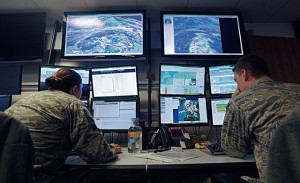
Snow plows are prepared to clear an airfield, a base is issued a delayed reporting notification, and the running portion of a physical fitness assessment is moved inside.
While these events may seem unrelated, they all have one thing in common: a weather forecast played a part in the decision.
Weather is something many people may not consciously think about until it affects their routine, but for the Airmen at the 21st Operational Weather Squadron, weather is at the front of their minds.
“We provide timely, accurate and relevant weather intelligence to make sure the U.S. European Command and U.S. Africa Command missions are met,” said 2nd Lt. Daniel Bazemore, 21st OWS weather officer.
The 21st OWS provides forecasts, weather advisories and resource protection warnings for Air Force, Army and Navy facilities within U.S. European Command and U.S. Africa Command.
The 21st OWS Airmen work with their counterparts throughout both commands’ areas of responsibility to ensure the products are as accurate as possible.
“We have weather flights that we support all throughout those AORs,” said Staff Sgt. James Hale, 21st OWS weather forecaster. “Any mission that takes off in either of those AORs has to get weather information from us before they can take off.”
To provide accurate data, the 21st OWS Airmen will contact a weather flight in the area for which they are making a weather forecast. After monitoring weather patterns, they contact a local weather flight to get a visual confirmation of what they are forecasting.
However, there are some monitored areas where there is no local weather flight to provide responses on their weather forecasts. In instances such as these, the 21st OWS relies on satellite imaging or observations from a mechanical tool or their customers.
“In regions where radar is sparse, we are highly dependent upon observations,” Bazemore said. “That comes from civilian observations or our observational equipment. That’s the great thing about satellite observation. Even if we don’t have a surface observation, we do have an image on that area from our eye in the sky.”
Feedback on the quality of their forecasts isn’t the only time weather forecasters speak with their customers.
“In the flight-weather briefing section, we provide weather forecasts for our pilots,” Hale said. “We receive (a) pilot-to-metro-service call, which is a phone line patch from an airborne pilot who needs quick and relevant weather information.”
According to Hale, a pilot-to-metro-service call shouldn’t last more than one to two minutes. Thus, the weather forecaster has to be certified to be in the section and capable of accessing all the information required to inform the pilot of how the weather is expected to behave on their route.
“The most rewarding part for me is working in that section,” Hale said. “I can actually see the end result of what I’m supporting. I write forecasts every day, but I have no idea what customer is using them. I know everyone is using them, but I don’t know for what purpose. When I’m giving a pilot weather information directly, I get to see how that impacts the mission.”
Similarly, many people are probably not aware that they are using the products from the 21st OWS, as they don’t just provide weather forecasts for flying missions. The weather forecasters produce approximately three products a day for the 11 areas they monitor around the clock.
“We touch entire installations,” Bazemore said. “Weather affects personnel, maintenance or whatever it might be. We get the reports to the decision makers so they make the appropriate call.”
Whether it is pulling maintainers off the flight line because of the heat index, redirecting a mission to another location because of inclement weather, or informing the populace the roads are safe to drive on, the decision was likely made based on a product from a weather forecaster.
Just as the weather they monitor does, the 21st OWS Airmen affect everyone under their scope.


